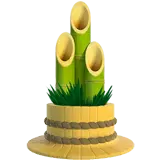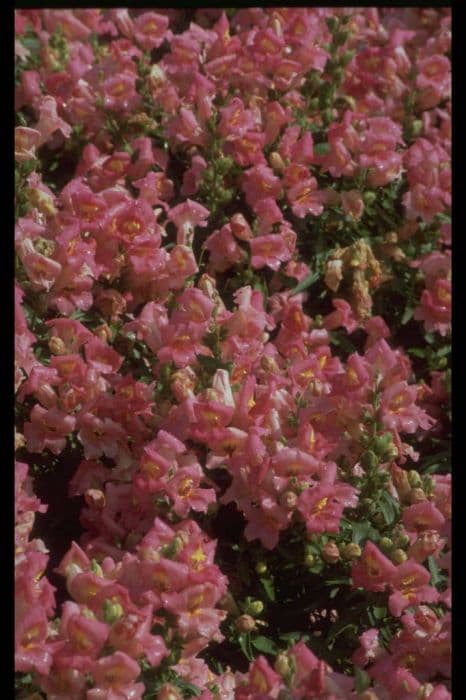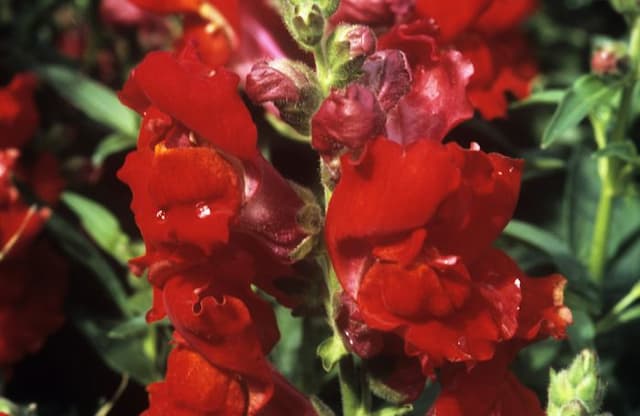Anderson's Hebe Hebe × andersonii

ABOUT
Hebe × andersonii, commonly known as the Anderson's hebe, is a decorative evergreen shrub with a dense and bushy appearance. Its foliage consists of glossy, spear-shaped leaves that are a deep green color. These leaves are quite attractive and are arranged oppositely along the stems which gives it a neat, orderly look. The Anderson's hebe is also admired for its flowers which appear in abundant spikes. These flowers typically bloom in shades of lilac, violet, or pale purple, adding a burst of color to the plant. The flower spikes are often long and densely packed with small flowers that can add a soft textural contrast to the glossy leaves. The shrub itself has a rounded form, contributing to its lush and full appearance in a garden setting. The branches are sturdy and may spread to give the plant a robust presence. This is a plant that provides year-round interest due to its evergreen nature, with the added bonus of a colorful floral display during its blooming season.
About this plant
 Names
NamesFamily
Plantaginaceae
Synonyms
Anderson's Hebe, Shrubby Veronica, Veronica Andersonii
Common names
Hebe × andersonii
 Toxicity
ToxicityTo humans
Anderson's hebe is not widely known for its toxicity to humans. There is limited information available on its toxicity, and it's typically not considered a hazardous plant. However, as with many ornamental plants, it is not intended for consumption. If ingested in large quantities, it could potentially cause digestive discomfort. To ensure safety, it is recommended that any part of Anderson's hebe not be ingested, and parents should ensure that children do not consume any part of the plant.
To pets
Anderson's hebe is not popularly recognized for being toxic to pets. There is a scarcity of information regarding its potential effects when ingested by animals, and it is generally not considered a dangerous plant for pets. Nevertheless, consumption of ornamental plants can sometimes lead to mild gastrointestinal upset in pets, such as vomiting or diarrhea. As a precaution, it's advisable to prevent pets from ingesting any part of Anderson's hebe. If you suspect your pet has ingested this plant and is showing symptoms of distress, contact your veterinarian.
 Characteristics
CharacteristicsLife cycle
Perennials
Foliage type
Evergreen
Color of leaves
Green
Flower color
Purple
Height
3 feet (0.91 meters)
Spread
3 feet (0.91 meters)
Plant type
Shrub
Hardiness zones
8
Native area
New Zealand
Benefits
 General Benefits
General Benefits- Ornamental Appeal: Hebe × andersonii, also known as Anderson's hebe, adds visual interest to gardens with its attractive foliage and flowers.
- Low Maintenance: As a hardy plant, Anderson's hebe requires minimal care once established, making it ideal for busy gardeners.
- Drought Tolerance: The plant can survive with little water, making it suitable for xeriscaping and drought-prone areas.
- Habitat Support: It provides nectar for bees and other pollinators, supporting local ecosystems.
- Versatility: Anderson's hebe can be planted in borders, containers, or as ground cover, making it adaptable to various garden designs.
- Year-Round Interest: With evergreen leaves and blooming seasons that can extend from spring to fall, it offers year-round garden interest.
- Seaside Suitability: It is tolerant of sea spray and windy conditions, which is perfect for coastal gardens.
- Urban Tolerant: The plant can thrive in urban conditions, coping well with pollution and limited space.
- Erosion Control: Its root system can help stabilize soil on slopes, preventing erosion.
 Medical Properties
Medical PropertiesThis plant is not used for medical purposes.
 Air-purifying Qualities
Air-purifying QualitiesThis plant is not specifically known for air purifying qualities.
 Other Uses
Other Uses- As a natural dye source: Hebe andersonii leaves can potentially be used to extract natural green dyes for coloring wool, fabrics, or art materials.
- Insectary plant for gardens: It can attract beneficial insects that help control garden pests.
- Creative arts and crafts: The stems and flowers of Hebe andersonii can be used in floral arrangements or dried for decorative purposes.
- Frozen floral ice bowls: The flowers can be frozen into ice bowls to serve as elegant, botanical containers for chilled desserts or beverages at events.
- Edging for pathways: Because of its compact size, it can serve as a natural border along garden paths.
- Erosion control: The plant can help prevent soil erosion on slopes due to its rooting system.
- Photography subject: Due to its attractive blooms, Hebe andersonii can be used as a subject for botanical photography.
- Educational tool: It can be used in educational gardens or institutions to teach about plant biology and horticulture.
- Green roofing: It could be implemented in green roof projects for its low-growing habit and hardiness.
- Theme gardens: This plant could be used to create a purple and green color-themed garden area.
Interesting Facts
 Feng Shui
Feng ShuiThe plant Hebe is not used in Feng Shui practice.
 Zodiac Sign Compitability
Zodiac Sign CompitabilityThe plant Hebe is not used in astrology practice.
 Plant Symbolism
Plant Symbolism- Youth: Named after Hebe, the Greek goddess of youth, Hebe × andersonii symbolizes perpetual youth and freshness.
- Rejuvenation: Reflecting its vigorous growth and ability to bounce back after pruning, this plant represents the ability to rejuvenate and restore oneself.
- Unity: As a hybrid plant, Hebe × andersonii symbolizes the coming together of different elements to create something beautiful, signifying unity and cooperation.
 Water
WaterAnderson's hebe should be watered deeply but infrequently, allowing the soil to dry out between waterings. During the growing season, it's typically necessary to water once every week, providing about 1 to 1.5 gallons per plant, depending on the size and environmental conditions. In the cooler months, reduce watering to every two weeks or less, as the plant requires less moisture. Adjust watering based on rainfall, ensuring the plant doesn't sit in soggy soil.
 Light
LightAnderson's hebe thrives in full sun to partial shade. The ideal spot for this plant would be where it can receive at least six hours of sunlight daily, while being protected from the harsh afternoon sun that can be too intense, especially in hotter climates. A location with morning sun and dappled afternoon shade is perfect to meet its light requirements.
 Temperature
TemperatureAnderson's hebe prefers moderate temperatures and can generally tolerate a range between 30°F to 75°F. The ideal temperature range for this plant is between 50°F and 70°F. It's important to protect the plant from extreme cold, as temperatures below 30°F can cause damage to the foliage and compromise its survival.
 Pruning
PruningAnderson's hebe should be pruned to maintain shape and encourage bushier growth. The best time for pruning is in the spring, just after the last frost. Pruning can be done annually, removing old flowers and any damaged or overgrown branches. Light pruning can also stimulate new growth, keeping the plant looking its best.
 Cleaning
CleaningAs needed
 Soil
SoilShrubby Veronica requires a well-draining soil mix with peat, perlite, and loam. The soil pH should be slightly acidic to neutral, between 6.0 and 7.0, to support healthy growth.
 Repotting
RepottingShrubby Veronica should be repotted every 2 to 3 years or when it becomes root-bound. Spring is the ideal time for repotting to encourage new growth.
 Humidity & Misting
Humidity & MistingShrubby Veronica thrives best in moderate humidity levels. It is adaptable to average home humidity but benefits from increased humidity when possible.
 Suitable locations
Suitable locationsIndoor
Bright, indirect light; well-draining soil; keep moderately moist.
Outdoor
Plant in well-drained soil; protect from harsh frost; partial sun.
Hardiness zone
7-10 USDA
 Life cycle
Life cycleAnderson's Hebe, or Hebe × andersonii, begins its life cycle with seed germination, where environmental conditions such as temperature and moisture trigger the growth of a new plant from a seed. Following germination, the seedling goes through a period of vegetative growth, developing roots, stems, and leaves as it matures. Once mature enough, the plant enters the flowering stage, producing small, typically purple or violet flowers attractive to pollinators. Post-pollination, if successful fertilization occurs, the plant produces fruit in the form of capsules that contain seeds. These seeds are then dispersed by various means such as wind, water, or animals, concluding the reproductive stage. Finally, after several years depending on the conditions and care received, the plant will reach senescence and die, although it often leaves behind numerous seeds to continue the cycle.
 Propogation
PropogationPropogation time
Spring-Early Summer
Propogation: Hebe × andersonii, commonly known as Shrubby veronica, is often propagated by semi-hardwood cuttings. The best time for propagation is typically late summer to early fall. To do this, you would take a cutting approximately 4 to 6 inches (10 to 15 centimeters) long from a healthy parent plant, ensuring that it includes at least two sets of leaves. Strip the lower leaves and dip the cut end into rooting hormone powder to encourage root development. Then, plant the cutting in a pot filled with a mixture of peat and perlite or sand to ensure good drainage. The cutting should be kept in a warm environment with indirect sunlight and maintained slightly moist until it has rooted, which usually takes a few weeks. After the roots have formed, the new plant can be gradually acclimated to outdoor conditions before being planted in its final location.









